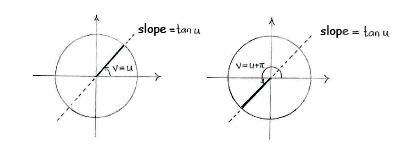Solution 4.4:5b
From Förberedande kurs i matematik 1
(Difference between revisions)
m (Lösning 4.4:5b moved to Solution 4.4:5b: Robot: moved page) |
m |
||
| (One intermediate revision not shown.) | |||
| Line 1: | Line 1: | ||
| - | {{ | + | Let's first investigate when the equality |
| - | < | + | |
| - | + | {{Displayed math||<math>\tan u=\tan v</math>}} | |
| - | {{ | + | |
| - | < | + | is satisfied. Because <math>\tan u</math> can be interpreted as the slope (gradient) of the line which makes an angle ''u'' with the positive ''x''-axis, we see that for a fixed value of <math>\tan u</math>, there are two angles ''v'' in the unit circle with this slope, |
| - | + | ||
| + | {{Displayed math||<math>v=u\qquad\text{and}\qquad v=u+\pi\,\textrm{.}</math>}} | ||
[[Image:4_4_5_b.gif|center]] | [[Image:4_4_5_b.gif|center]] | ||
| + | |||
| + | The angle ''v'' has the same slope after every half turn, so if we add multiples of | ||
| + | <math>\pi</math> to ''u'', we will obtain all the angles ''v'' which satisfy the equality | ||
| + | |||
| + | {{Displayed math||<math>v=u+n\pi\,,</math>}} | ||
| + | |||
| + | where ''n'' is an arbitrary integer. | ||
| + | |||
| + | If we apply this result to the equation | ||
| + | |||
| + | {{Displayed math||<math>\tan x=\tan 4x</math>}} | ||
| + | |||
| + | we see that the solutions are given by | ||
| + | |||
| + | {{Displayed math||<math>4x = x+n\pi\qquad\text{(n is an arbitrary integer),}</math>}} | ||
| + | |||
| + | and solving for ''x'' gives | ||
| + | |||
| + | {{Displayed math||<math>x = \tfrac{1}{3}n\pi\qquad\text{(n is an arbitrary integer).}</math>}} | ||
Current revision
Let's first investigate when the equality
| \displaystyle \tan u=\tan v |
is satisfied. Because \displaystyle \tan u can be interpreted as the slope (gradient) of the line which makes an angle u with the positive x-axis, we see that for a fixed value of \displaystyle \tan u, there are two angles v in the unit circle with this slope,
| \displaystyle v=u\qquad\text{and}\qquad v=u+\pi\,\textrm{.} |
The angle v has the same slope after every half turn, so if we add multiples of \displaystyle \pi to u, we will obtain all the angles v which satisfy the equality
| \displaystyle v=u+n\pi\,, |
where n is an arbitrary integer.
If we apply this result to the equation
| \displaystyle \tan x=\tan 4x |
we see that the solutions are given by
| \displaystyle 4x = x+n\pi\qquad\text{(n is an arbitrary integer),} |
and solving for x gives
| \displaystyle x = \tfrac{1}{3}n\pi\qquad\text{(n is an arbitrary integer).} |

